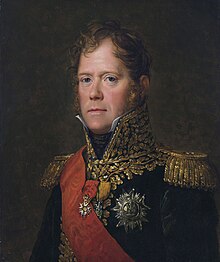Michel Ney
Michel Ney (French pronunciation: [miʃɛl ˈnɛ]), 1st Duc d'Elchingen, 1st Prince de la Moskowa (10 January 1769 – 7 December 1815), popularly known as Marshal Ney, was a French soldier and military commander during the French Revolutionary Wars and the Napoleonic Wars. He was one of the original 18 Marshals of the Empire created by Napoleon. He was known as Le Rougeaud ("red faced" or "ruddy")[1] by his men and nicknamed le Brave des Braves ("the bravest of the brave") by Napoleon.
Early life
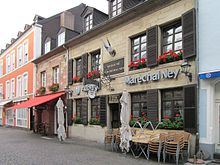
Michel Ney was born in the town of Sarrelouis along the French–German border. He was the second son of Pierre Ney (1738–1826), a master barrel-cooper and veteran of the Seven Years' War, and his wife Margarethe Grewelinger (1739–1791). He was the paternal grandson of Matthias Ney (1700–1780) and wife Margarethe Becker (d. 1767), and the maternal grandson of Valentin Grewelinger and wife Margaretha Ding.[2] His hometown at the time of his birth comprised a French enclave in a predominantly German region of Saarland, and Ney grew up bilingual, due to his German roots.
He was educated at the Collège des Augustins, became a notary in Saarlouis and then subsequently became an overseer of mines and forges.
Military career
French Revolutionary Wars

Life as a civil servant did not suit Ney, and he enlisted in the Colonel-General Hussar Regiment in 1787.[2]Under the Bourbon Monarchy entry to the officer corps of the French Army was restricted to those with four quarterings of nobility (i.e. several generations of aristocratic birth). However Ney rapidly rose through the non-commissioned ranks. He served in the Army of the North from 1792 to 1794, with which he saw action at the Cannonade of Valmy, the Battle of Neerwinden, and other engagements. Ney was commissioned in October 1792, transferred to the Army of Sambre-et-Meuse in June 1794, and wounded at the Siege of Mainz. Ney was promoted to général de brigade in August 1796, and commanded cavalry on the German fronts. On 17 April 1797, during the Battle of Neuwied, Ney led a cavalry charge against Austrian lancers trying to seize French cannons. The lancers were beaten back, but Ney’s cavalry were counter-attacked by heavy cavalry. During the mêlée, Ney was thrown from his horse and made a prisoner of war; on 8 May he was exchanged for an Austrian general.[3] Following the capture of Mannheim, Ney was promoted to géneral de division in March 1799. Later in 1799, Ney commanded cavalry in the armies of Switzerland and the Danube. At Winterthur Ney received wounds in the thigh and wrist. After Ney’s recovery he fought at Hohenlinden under General Moreau in December 1800. From September 1802, Ney commanded French troops in Switzerland and performed diplomatic duties.
Napoleonic Wars

On 19 May 1804, Ney received his Marshal's baton, emblematic of his status as a Marshal of the Empire, the Napoleonic era's equivalent of Marshal of France.[4] In the 1805 campaign, Ney took command of VI Corps of the Grande Armée and was praised for his conduct at Elchingen.[4] In November 1805, Ney invaded the Tyrol, capturing Innsbruck from Archduke John. In the 1806 campaign, Ney fought at Jena and then occupied Erfurt. Later in the campaign, Ney successfully besieged Magdeburg. In the 1807 campaign, Ney arrived with reinforcements in time to save Napoleon from defeat at Eylau, although the battle ended in a draw. Later in the campaign, Ney fought at Güttstadt and commanded the right wing at Friedland. On 6 June 1808, Ney was created Duke of Elchingen.[4] In August 1808, he was sent to Spain in command of VI Corps and won a number of minor actions. In 1809, he routed an Anglo-Portuguese force under Sir Robert Wilson at Baños. In 1810, Ney joined Marshal Masséna in the invasion of Portugal, where he took Ciudad Rodrigo from the Spanish and Almeida from the British and Portuguese, brusquely defeated a British force on the River Côa, and fought at Bussaco. During the retreat from Torres Vedras, Ney engaged Wellington's forces in a series of lauded rearguard actions (Pombal, Redinha, Casal Novo, Foz d'Arouce) through which he delayed the pursuing enemy forces long enough to allow the main French force to retreat unmolested. He was ultimately removed from his command for insubordination.[4]
Russia to Fontainebleau
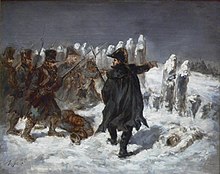
Ney was given command of III Corps of the Grande Armée during the 1812 invasion of Russia. At Smolensk, Ney was wounded in the neck, but recovered enough to later fight in the central sector at Borodino. During the retreat from Moscow, Ney commanded the rearguard (and was anecdotally known as "the last Frenchman on Russian soil" because of it). After being cut off from the main army, Ney managed to rejoin it, which delighted Napoleon.[4] For this action Ney was given the nickname "the bravest of the brave" by Napoleon.[4] Ney fought at Beresina and helped hold the vital bridge at Kovno (modern-day Kaunas), where legend portrays Ney as the last of the invaders to cross the bridge and exit Russia.[4] On 25 March 1813, Ney was given the title of Prince de la Moskowa.[4] During the 1813 campaign Ney fought at Battle of Weissenfels, was wounded at Lützen, and commanded the left wing at Bautzen. Ney later fought at Dennewitz and Leipzig, where he was again wounded. In the 1814 campaign in France, Ney fought various battles and commanded various units. At Fontainebleau Ney became the spokesperson for the Marshals' revolt on 4 April 1814, demanding Napoleon's abdication. Ney informed Napoleon that the army would not march on Paris; Napoleon responded "the army will obey me!" to which Ney answered, "the army will obey its chiefs".[5]
When Paris fell and the Bourbons reclaimed the throne, Ney, who had pressured Napoleon to accept his first abdication and exile, was promoted, lauded, and made a peer by the newly enthroned Louis XVIII. Although Ney had pledged his allegiance to the restored monarchy, the Bourbon court looked down on him because he was a commoner by birth.
The Hundred Days campaign
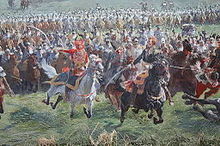

When he heard of Napoleon's return to France, Ney, determined to keep France at peace and to show his loyalty to Louis XVIII, organized a force to stop Napoleon's march on Paris. Ney also pledged to bring Napoleon back alive in an iron cage. Napoleon, aware of Ney's plans, sent him a letter which said, in part, "I shall receive you as I did after the Battle of the Moskowa".[6] Despite Ney’s promise to the King, he joined Napoleon at Auxerre on 18 March 1815.
On 15 June 1815, Napoleon appointed Ney commander of the left wing of the Army of the North. On 16 June Napoleon's forces split up into two wings to fight two separate battles simultaneously. Ney attacked Wellington at Quatre Bras (and received criticism for attacking slowly,[7]) while Napoleon attacked Blücher's Prussians at Ligny. Although Ney was criticized for not capturing Quatre Bras early, there is still debate as to what time Napoleon actually ordered Ney to capture Quatre Bras.[8] At Ligny, Napoleon ordered General d'Erlon to move his corps (on Napoleon's left and Ney's right at the time) to the Prussians' rear in order to cut off their line of retreat. D'Erlon began to move into position, but suddenly stopped and began moving away, much to the surprise and horror of Napoleon. The reason for the sudden change in movement is that Ney had ordered d'Erlon to come to his aid at Quatre Bras. Without d'Erlon's corps blocking the Prussians' line of retreat, the French victory at Ligny was not complete, and the Prussians were not routed.[9]
At Waterloo Ney again commanded the left wing of the army. At around 3:30 p.m., Ney ordered a mass cavalry charge against the Anglo-Allied line. Ney's cavalry overran the enemy cannons, but found the infantry formed in cavalry-proof square formations. Ney, without infantry or artillery support, failed to break the squares. The action earned Ney criticism, and some argue that it led to Napoleon's defeat at Waterloo.[7] Debate continues[citation needed] as to the responsibility for the cavalry charge and why it went unsupported. Ney's cavalry also failed to spike enemy cannon (driving iron spikes into the firing holes) while they were under French control (during the cavalry attack, the crews of the cannon retreated into the squares for protection, and then re-manned their pieces as the horsemen withdrew). Ney's cavalry carried the equipment needed to spike cannons, and spiking the cannons would probably have made them useless for the rest of the battle. The loss of a large number of cannon would have weakened the army and could have caused the Anglo-Allied force to withdraw from the battle.[10] Ney was seen [11] during one of the charges beating his sword against the side of a British cannon in furious frustration. During the battle he had five horses killed under him;[12] and at the end of the day, Ney led one of the last infantry charges, shouting to his men: "Come see how a marshal of France dies!".[13] It was as though Ney was seeking death, but death did not want him, as many observers reported.[14][15]
Execution
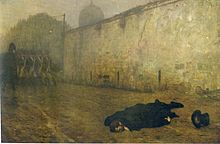
by Jean-Léon Gérôme
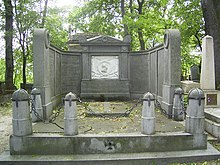
When Napoleon was defeated, dethroned, and exiled for the second time in the summer of 1815, Ney was arrested (on 3 August 1815). After a court-martial declared itself incompetent (November), he was tried (4 December 1815) for treason by the Chamber of Peers. In order to save Ney's life, his lawyer Dupin declared that Ney was now Prussian and could not be judged by a French court for treason as Ney's hometown of Sarrelouis had been annexed by Prussia according to the Treaty of Paris of 1815. Ney ruined his lawyer's effort by interrupting him and stating: "I am French and I will remain French".[16] On 6 December 1815, he was condemned, and executed by firing squad in Paris near the Luxembourg Garden on 7 December 1815, an event that deeply divided the French public. He refused to wear a blindfold and was allowed the right to give the order to fire, reportedly saying:
"Soldiers, when I give the command to fire, fire straight at my heart. Wait for the order. It will be my last to you. I protest against my condemnation. I have fought a hundred battles for France, and not one against her ... Soldiers, fire!"[17]
Ney's execution was an example intended for Napoleon's other marshals and generals, many of whom were eventually exonerated by the Bourbon monarchy. Ney is buried in Paris at Père Lachaise Cemetery.
Family
[clarification needed See Talk page]

Ney married Aglaé Louise Auguié (Paris, 24 March 1782 – Paris, 1 July 1854) at Thiverval-Grignon on 5 August 1802. Aglaé was the daughter of Pierre César Auguié (1738–1815) and Adélaïde Henriette Genet (1758–1794). Her paternal grandparents were Pierre César Auguié (1708–1776) and Marie Guary (1709–1788); her maternal grandparents were Edmé Jacques Genet (1726–1781) and Marie Anne Louise Cardon who were the parents of Edmond-Charles Genêt and Jeanne-Louise-Henriette Campan.[18]
Ney and his wife had four sons:[citation needed]
- Joseph Napoléon, 2nd Prince de La Moskowa (Paris, 8 May 1803–Saint-Germain-en-Laye, 25 July 1857). Married Albine Laffitte (Paris, 12 May 1805-Paris, 18 July 1881) in Paris on 26 January 1828, by whom he had issue. The male line of his descendants is now extinct. Joseph also had an illegitimate son who was married without issue.
- Michel Louis Félix, recognized as 2nd Duc d'Elchingen 1826 (Paris, 24 August 1804–Gallipoli, during the Crimean War, 14 July 1854). He married Marie-Joséphine Souham (Lubersac, 20 December 1801–Versailles, 1 July 1889) in Paris on 19 January 1833, by whom he had issue, with the male line becoming extinct in 1969.
- Eugène Michel (Paris, 12 July 1806-Paris, 25 October 1845), who died unmarried and without issue.
- Edgar Napoléon Henry, recognized as 3rd Prince de La Moskowa 1857 (Paris, 12 April 1812-Paris, 4 October 1882), who married Clotilde de La Rochelambert (Saint-Cloud, 29 July 1829-Paris, 1884) in Paris on 16 January 1869, but died without issue; the title of Prince de la Moskowa then reverted to Michel's issue.
He was related to Hubert Ney.
In film
Ney has been portrayed by a number of actors throughout the years.
- By Dan O'Herlihy in Waterloo from 1970 and Carl de Vogt in Waterloo from 1929.
- By Colin Bean in the episode "A Soldier's Farewell" of the British sitcom Dad's Army
- By Alain Doutey in the miniseries Napoléon
- By Russian actor Aleksandr Stepanov in the Russian propaganda film Kutuzov from 1944
- By John Baker in the British series War and Peace
See also
- HMS Marshal Ney, a British warship named after Ney
Notes
- ^ Raymond Horricks 'Marshal Ney, The Romance And The Real' (ISBN 0882546554)
- ^ a b Chandler 1999, p. 360.
- ^ Atteridge, p.25
- ^ a b c d e f g h Chandler 1999, p.314
- ^ Gates., p.259
- ^ Markham., p.261. "The Battle of the Moskowa" refers to the Battle of Borodino
- ^ a b Chandler 1999, p.315
- ^ Roberts., p.116
- ^ Markham., p.272
- ^ Markham., p.276
- ^ David Howarth, page 132 "Waterloo: Day of Battle", ISBN 0-88365-273-0,
- ^ D.H. Parry (c. 1900) Battle of the nineteenth century, Vol 1 Cassell and Company: London. Waterloo
- ^ Jacques Le Coustumier, Le Maréchal Victor
- ^ Eugène-Melchior de Vogüé, Le Procès du maréchal Ney [1]
- ^ Jonathan Gillespie-Payne, Waterloo: In the Footsteps of the Commanders, p.111, 2004 [2]
- ^ Pierre Bellemare,Jean-François Nahmias, La Terrible vérité: 26 grandes énigmes de l'histoire enfin résolues, 2008 [3]
- ^ Tsouras., p.245.
- ^ Atteridge, pp. 107–109
References
- Atteridge, A.H (2005). Marshal Ney: The Bravest of the Brave. Pen & Sword.
- Chandler, David (editor) (1987). Napoleon's Marshals. London: Macmillan Publishing Company. ISBN 0-297-79124-9.
{{cite book}}:|first=has generic name (help) - Chandler, David (1999). Dictionary of the Napoleonic wars. Wordsworth editions.
- Gates, D (2003). The Napoleonic Wars, 1803–1815. Pimlico.
- Horricks, Raymond. Marshal Ney, The Romance And The Real. ISBN 0882546554.
- Kurtz, Harold (1957). The Trial of Marshal Ney: His Last Years and Death. New York: Alfred A. Knopf.
- Markham, J. D (2003). Napoleon’s Road to Glory: Triumphs, Defeats, and Immortality. Brassey’s.
- Roberts, A (2005). Waterloo, June 18, 1815: The Battle for Modern Europe. Harper-Collins Publishing.
- Tsouras, P.G. (2005). The book of Military Quotations. Zenith Press.
- 1769 births
- 1815 deaths
- People from Saarlouis
- French commanders of the Napoleonic Wars
- Commanders in the French Imperial Guard
- Marshals of France
- Dukes of Elchingen
- Princes de la Moskowa
- Grand Croix of the Légion d'honneur
- People executed by France by firing squad
- Burials at Père Lachaise Cemetery
- People executed for treason against France
- Cavalry commanders
- French people executed by firing squad
- People executed by the Bourbon dynasty of the Kingdom of France
- Executed military leaders
- Peers of France
- Executed people from Saarland
- Names inscribed under the Arc de Triomphe
- French people of German descent

